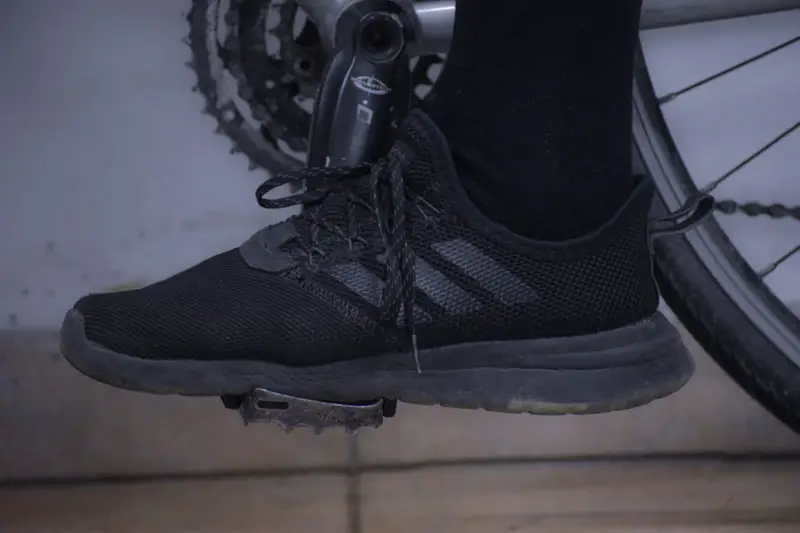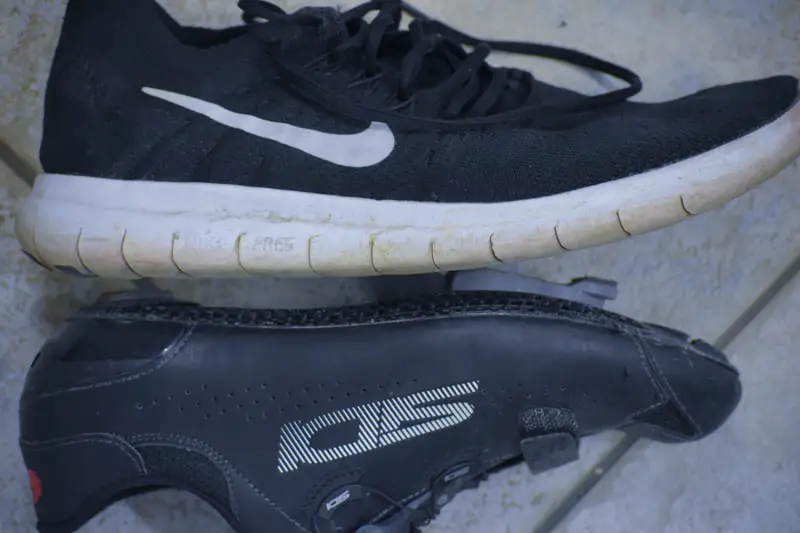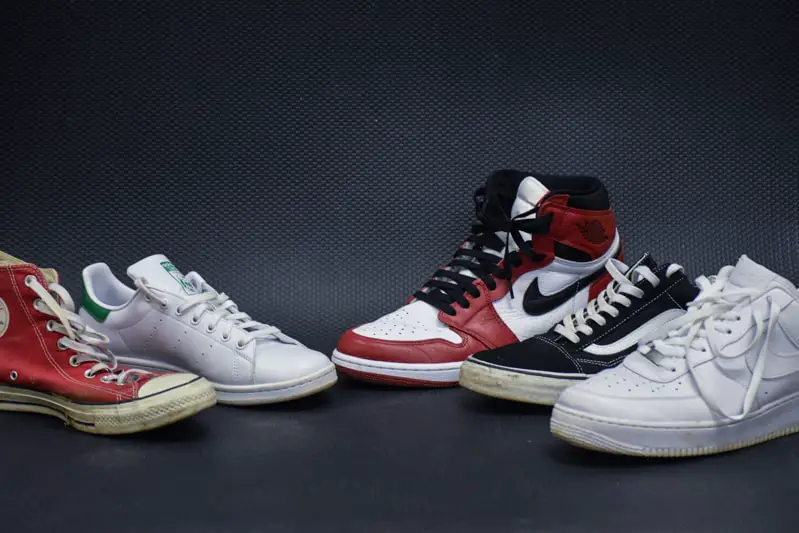Many people often do both cycling and running. Although the two sports are similar in some respects, each requires its own equipment. But is it possible to save a few dollars by using the same shoes for both sports?
Running shoes are not suitable for cycling. Their soft sole compresses and flexes when pedaling, causing energy loss. On longer rides, constant foot flexing and compression of the nerves also causes pain, known as ‘hot-foot‘.
There is a good reason cycling shoes were invented. They offer a better riding experience. However, some people don’t like them, so I will discuss why they are superior to running shoes and later present you with a few alternatives to running shoes if you really don’t want to cycle in cycling shoes.
You should start using cycling shoes as soon as possible. You can check my recommendation by clicking here.
Why are running shoes not suitable for cycling?
Running shoes are made for running, and cycling shoes are made for cycling. Their characteristics reflect the requirements of the sport, which are totally different from running and cycling.
When running, you want your shoe to cushion the forces on contact with the ground as much as possible. Therefore, the sole is soft and flexible, the opposite of what cycling requires.
A cycling shoe has to have a stiff sole, so you don’t waste energy on every pedal stroke. The stiffer the sole, the more energy produced will transfer to the pedal, which results in a more efficient ride.

Even though energy loss per pedal stroke is slight, you get a disturbingly high number of wasted watts when you multiply it by the number of pedal strokes per ride.
Choosing the right shoe will make your ride more efficient, which means you’ll be faster on the bike and less tired at the end of the day.
Cycling in running shoes can cause ‘hot-foot’
The soft sole of the running shoe causes constant pressure on the ball of the foot when pedaling. As a result, stress is also transferred to the nerves between the metatarsal bones. That causes a burning sensation in your feet, known as ‘hot-foot’.
‘Hot-foot’ occurs after a prolonged period of increased pressure on the nerves at the ball of the foot. Your feet feel like they are on fire, but the pain is only psychological.
A few-minute break will help you decrease the burning sensation, but it will likely return once you start pedaling again. The only solution to prevent it completely is to choose the right footwear. Spoiler alert: running shoes are not!
How do running shoes differ from cycling shoes
A running shoe is much different from a cycling shoe. The main difference is the sole, but even the other parts are too different for a running shoe to be a proper cycling shoe.
The sole is soft
I already talked about the problem of a soft sole. That’s the most significant difference between a running and cycling shoe and consequently, the biggest downside of the running shoe.
The sole of a running shoe usually is 0.8 inches (20 mm) thick, while the sole of a cycling shoe is no more than 0.4 inches (10 mm) thick.

That means that with running shoes, you need to compress twice as much material before the energy is transferred to the pedal. And note that the cycling shoe sole doesn’t need much compressing in the first place, as it’s stiff enough to transfer the energy directly to the pedal.
The energy loss alone is enough for you to switch to cycling shoes, but if you’re adding the potential pain and discomfort on a ride, then the purchase of cycling shoes is a no-brainer.
The sole is flexible
Softness and flexibility go hand in hand. And none of them is welcome at cycling.
Running shoes are flexible for a good reason. They need to adjust to different foot positions before and after contact with the ground, so flexibility is therefore crucial.
At cycling, there isn’t much different movement on a shoe level. The sole is straight all the time as there isn’t any need for flexing.
What is good and mandatory for running is not welcome in cycling. The shoe that bends around the pedal should stay away from the bike, as additional energy loss is something we really don’t want.
So now we have two dimensions – compression and flexion – that take energy every time the pedal is turned. You can probably imagine how little of it is actually transferred to the pedal.
Soft upper of the shoe

Running shoes need to be as comfortable as possible. Therefore, the upper of the shoe is really soft. You feel like you’re running in slippers.
That might be good for comfort, but it’s not very efficient at controlling the side movement. And there is quite some of it in cycling. We want to prevent it as much as possible. Once again, the main reason is energy loss.
Cycling shoes have a much harder upper. In this way, lateral movement is limited, while the comfort is entirely satisfactory.
Can you wear running shoes on shorter rides?
Running shoes are an okay option for cycling if you need to go to the store or the office. You don’t need to wear cycling shoes for this, as you would have to change shoes at the destination.
Also, the energy wasted on such rides is not important, as our primary goal is to get to the destination, whatever the pace.
The running shoes are suitable for commuting and rides up to 5 miles, where the main goal is to get to a specific destination. You should wear cycling shoes on any longer rides, where the main focus is the riding itself.
Even on commutes, there are better shoe choices than running shoes. Most everyday shoes have a stiffer sole that is more suitable for pedaling.
However, if you’re commuting in your everyday shoes that you’re also wearing in an office, be sure to protect the chain on the bike. Otherwise, you will get an ugly black stain on them sooner or later, which is hard to remove.
Can I use any other non-cycling shoes for cycling?
There are millions and millions of shoes on the market, and some are even suitable for cycling. We already figured out that running shoes are not, but many other sports have similar shoe requirements to cycling.
Indoor sports mostly require shoes with stiff soles with good grip. Therefore, they also make great cycling shoes.
Basketball, indoor soccer (or football), volleyball, squash, handball… All the shoes you’re using there, you can use on a bicycle.
Most of the best non-cycling shoes for cycling can be found in other sport disciplines
Even some outdoor sports use bicycle-approved shoes. Tennis is one of them, but there’s one sport with even better shoes for cycling. Can you guess which?
If you said skateboarding, then congratulations – you are correct!
Skateboarding has similar shoe requirements to cycling. To perform tricks, you need a sturdy sole that immediately transfers the force of your foot to the ground. Sounds familiar, right?
The grip is also one of the main factors of skateboarding shoes. Cyclists also like grip, especially because with non-cycling shoes, you most likely use platform pedals, not clipless.
It’s not uncommon for your foot to slip off the pedal if the grip is not great. Mostly that’s just annoying, but it can sometimes lead to injuries. I had a few, but luckily nothing serious.
If you don’t know the difference between platform pedals and clipless pedals, you can read my article about it.
Best non-cycling shoes for cycling

I have selected ten non-cycling shoes that you can use for cycling. In addition to their suitability for cycling, I was also mindful that selected shoes are often used as everyday shoes.
All the selected shoes are made by popular brands recognized globally. That’s why they are available on Amazon, which you can access via the links provided.
Here’s my selection of the ten best non-cycling shoes for cycling:
- Nike Air Force 1
- Vans Ward
- adidas Superstar
- adidas Samba
- New Balance All Coast
- Converse All Star
- DC Anvil
- Five Ten Freerider
- Etnies Jameson 2
- Nike Air Jordan 1
All ten shoes above are great for commuting or a ride to the city center. However, if you’re serious about cycling, get cycling shoes, as the difference is massive.
As mentioned, the selected shoes are also great for everyday use. Most of us have at least one pair from the list at home. Use that pair for cycling, as you’ll enjoy your commuting much more.
However, if you’re planning on buying brand new shoes, I advise you to get one of the skateboarding shoes (Vans, Etnies, DC) or Five Tens. The latter are originally mountain biking shoes but are often used as everyday shoes.
Nike and Adidas shoes are already more casual, making them less adapted to sports use. Although they can still withstand the stresses of sport, they will wear out more quickly than some of the shoes mentioned above.
I need to mention one shoe that is not on the list. Adidas created model Velosamba specifically for bike commuters. It is an everyday shoe with a customized sole on which cleats can be fitted so that you can clip into the pedals.

